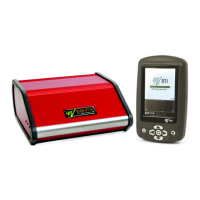5. Measurements with the Barracuda System
Dental and Panoramic Dental
Barracuda & QABrowser Reference Manual
2012-10/4.3A
152
5.7.2 Waveforms
The example below explains why a change of delay change the value of measured kVp
and the kV and radiation waveform on a one phase dental unit.
From the study of the above three screens several conclusions can be made:
1. A stable output level is not reached until after approximately 200 to 300 ms (20 to 30
pulses for a 50 Hz main based dental unit).
2. The exposure time is depending on the definition of the trig level.
3. The kVp value in the RTD is related to selected delay and window and is several kV
higher in the beginning of the exposure at the same time as the radiation level is
relative low here. Therefore a delay of 200 ms is default for the Barracuda.
If the signal to the detector is too low to give a correct kV value, this part
of the waveform will be blank. This is the reason why only the upper parts
of the kV waveform is displayed. To see more of the waveform, change
the kV range.
5.7.3 Panoramic Systems
Use the same procedure as for the normal dental measurement but select Panoramic
Dental instead of radiographic and select Tube Voltage as parameter. A 200 ms delay
is default.

